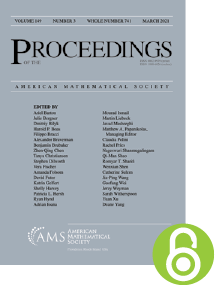Selective ultrafilters and $\omega \rightarrow (\omega )^\omega$
HTML articles powered by AMS MathViewer
- by Todd Eisworth PDF
- Proc. Amer. Math. Soc. 127 (1999), 3067-3071 Request permission
Abstract:
Mathias (Happy families, Ann. Math. Logic. 12 (1977), 59–111) proved that, assuming the existence of a Mahlo cardinal, it is consistent that CH holds and every set of reals in $L(\mathbb {R})$ is $\mathcal {U}$-Ramsey with respect to every selective ultrafilter $\mathcal {U}$. In this paper, we show that the large cardinal assumption cannot be weakened.References
- Fred Galvin and Karel Prikry, Borel sets and Ramsey’s theorem, J. Symbolic Logic 38 (1973), 193–198. MR 337630, DOI 10.2307/2272055
- J. M. Henle, A. R. D. Mathias, and W. Hugh Woodin, A barren extension, Methods in mathematical logic (Caracas, 1983) Lecture Notes in Math., vol. 1130, Springer, Berlin, 1985, pp. 195–207. MR 799042, DOI 10.1007/BFb0075312
- Kenneth Kunen, Some points in $\beta N$, Math. Proc. Cambridge Philos. Soc. 80 (1976), no. 3, 385–398. MR 427070, DOI 10.1017/S0305004100053032
- A. R. D. Mathias, Happy families, Ann. Math. Logic 12 (1977), no. 1, 59–111. MR 491197, DOI 10.1016/0003-4843(77)90006-7
- F.P. Ramsey. On a problem of formal logic. Proc. London Math. Soc., 30:264–286, 1930.
- Jack Silver, Every analytic set is Ramsey, J. Symbolic Logic 35 (1970), 60–64. MR 332480, DOI 10.2307/2271156
- Robert M. Solovay, A model of set-theory in which every set of reals is Lebesgue measurable, Ann. of Math. (2) 92 (1970), 1–56. MR 265151, DOI 10.2307/1970696
Additional Information
- Todd Eisworth
- Affiliation: Institute of Mathematics, The Hebrew Univeristy, Jerusalem, Israel
- Email: eisworth@math.huji.ac.il
- Received by editor(s): December 29, 1995
- Received by editor(s) in revised form: December 10, 1997
- Published electronically: April 23, 1999
- Additional Notes: This research is part of the author’s Ph.D. dissertation written at the University of Michigan under the supervision of Professor Andreas Blass. The author would like to thank the referee for his tips on streamlining the proof.
- Communicated by: Andreas R. Blass
- © Copyright 1999 American Mathematical Society
- Journal: Proc. Amer. Math. Soc. 127 (1999), 3067-3071
- MSC (1991): Primary 04A20
- DOI: https://doi.org/10.1090/S0002-9939-99-04835-2
- MathSciNet review: 1600136


